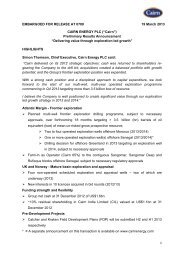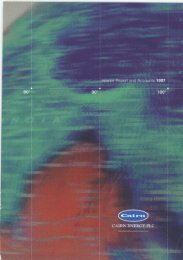Download Nautical Annual Report and ... - Cairn Energy PLC
Download Nautical Annual Report and ... - Cairn Energy PLC
Download Nautical Annual Report and ... - Cairn Energy PLC
Create successful ePaper yourself
Turn your PDF publications into a flip-book with our unique Google optimized e-Paper software.
<strong>Nautical</strong> Petroleum plc <strong>Annual</strong> report <strong>and</strong> accounts 2010<br />
36<br />
Notes to the financial statements continued<br />
2. Accounting policies for the consolidated financial statements continued<br />
(2.11) Financial liabilities<br />
Trade <strong>and</strong> other payables<br />
Current trade <strong>and</strong> other payables are initially recognised at fair value. Fair value is considered to be the original invoice amount,<br />
discounted where material.<br />
All financial liabilities as defined under IAS 39 are held at amortised cost.<br />
(2.12) Taxation<br />
Current tax<br />
Current tax assets <strong>and</strong> liabilities are measured at the amount expected to be recovered from or paid to the taxation authorities, based on<br />
tax rates <strong>and</strong> laws that are enacted or substantively enacted by the balance sheet date.<br />
Deferred tax<br />
Deferred income tax is recognised on all temporary differences arising between the tax bases of assets <strong>and</strong> liabilities <strong>and</strong> their carrying<br />
amounts in the financial statements, with the following exceptions:<br />
»» where the temporary difference arises from the initial recognition of goodwill or of an asset or liability in a transaction that is not a<br />
business combination that at the time of the transaction affects neither accounting nor taxable profit or loss;<br />
»» in respect of taxable temporary differences associated with investment in subsidiaries, associates <strong>and</strong> joint ventures, where the<br />
timing of the reversal of the temporary differences can be controlled <strong>and</strong> it is probable that the temporary differences will not reverse<br />
in the foreseeable future; <strong>and</strong><br />
»» deferred income assets are recognised only to the extent that it is probable that taxable profit will be available against which the<br />
deductible temporary differences, carried forward tax credits or tax losses can be utilised.<br />
Deferred income tax assets <strong>and</strong> liabilities are measured on an undiscounted basis at the tax rates that are expected to apply when the<br />
related asset is realised or liability is settled, based on tax rates <strong>and</strong> laws enacted or substantively enacted at the balance sheet date.<br />
The carrying amount of deferred income tax assets is reviewed at each balance sheet date. Deferred income tax assets <strong>and</strong> liabilities are<br />
offset, only if a legally enforcement right exists to set off current tax assets against current tax liabilities, the deferred income taxes relate<br />
to the same taxation authority <strong>and</strong> that authority permits the Group to make a single net payment.<br />
Income tax is charged or credited directly to equity if it relates to items that are credited or charged to equity. Otherwise income tax is<br />
recognised in the income statement.<br />
(2.13) Employee benefits<br />
The Group operates a defined contribution pension scheme. Contributions payable for the year are charged to the income statement.<br />
(2.14) Share-based payments<br />
The cost of equity-settled transactions is recognised, together with a corresponding increase in equity, over the year in which the<br />
performance <strong>and</strong>/or service conditions are fulfilled, ending on the date on which the relevant individuals become fully entitled to the<br />
award (“vesting point”). The cumulative expense recognised for equity-settled transactions at each reporting date until the vesting date<br />
reflects the extent to which the vesting period has expired <strong>and</strong> the Group’s best estimate of the number of equity instruments <strong>and</strong> value<br />
that will ultimately vest. The income statement charge for the year represents the movement in cumulative expense recognised as at the<br />
beginning <strong>and</strong> end of that year.<br />
The fair value of share-based remuneration is determined at the date of grant <strong>and</strong> recognised as an expense in the income statement on a<br />
straight-line basis over the vesting period, taking account of the estimated number of shares that will vest.<br />
The fair value is determined by use of a binomial model.<br />
(2.15) Separately disclosable items<br />
Items that are both material in size <strong>and</strong> unusual <strong>and</strong> infrequent in nature are presented as separately disclosable items in the income<br />
statement or separately disclosed in the notes to the financial statements. The Directors are of the opinion that the separate disclosure of<br />
these items provides helpful information about the Group’s underlying business performance.<br />
(2.16) Commitments <strong>and</strong> contingencies<br />
Commitments <strong>and</strong> contingent liabilities are not recognised in the financial statements. They are disclosed unless the possibility of an<br />
outflow of resources embodying economic benefits is remote. A contingent asset is not recognised in the financial statements but<br />
disclosed when an inflow of economic benefits is probable.<br />
(2.17) Changes in accounting policy<br />
The accounting policies adopted are consistent with those of the previous financial year except as described below. The following new<br />
<strong>and</strong> amended IFRS <strong>and</strong> IFRIC Interpretations are m<strong>and</strong>atory for periods beginning on or after 1 July 2009 unless otherwise stated. For<br />
each of the new or amended IFRS <strong>and</strong> IFRIC interpretations adopted in the period the impact on the financial statements or performance<br />
of the Group is described below:<br />
Amendment to IFRS 2 Share-based Payment: Vesting Conditions <strong>and</strong> Cancellations<br />
The amendment to IFRS 2 clarifies the definition of vesting conditions <strong>and</strong> prescribes the treatment for an award that is cancelled. This<br />
amendment did not have an impact on the financial position or performance of the Group.
















